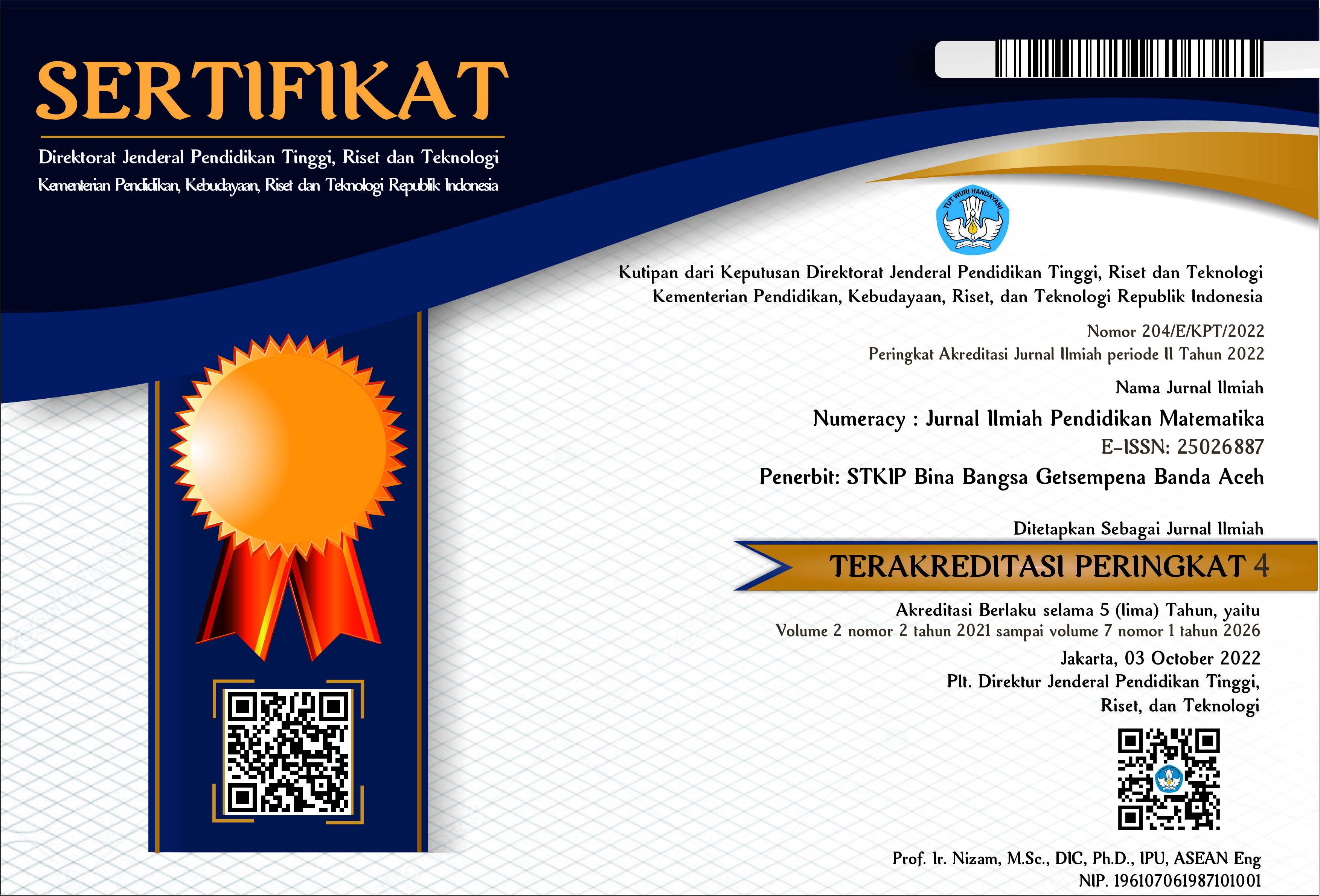KEMAMPUAN MENGKONSTRUKSI MODEL MATEMATIKA SISWA DENGAN PENDEKATAN MODEL ELICITING ACTIVITIES (MEAs) DI SMP NEGERI 3 PALEMBANG
Abstract
This research is descriptive research that aims to describe the ability to construct a mathematical model of students with model-eliciting activities (MEAs) approach in Palembang State Middle School 3. The subjects in this study were students of class VII.8 Palembang State Middle School 3 which numbered 31 people. This study uses data collection techniques in the form of tests, namely problem-solving questions with the competence to construct mathematical models, and interviews to obtain additional data. Based on the results of student tests, it is known that the percentage of the ability to construct mathematical models of students is not evenly distributed in each category, It can be said that the ability of students to construct mathematical models are good enough after using MEAs approach.
Abstrak
Penelitian ini merupakan penelitian deskriptif yang bertujuan untuk mendeskripsikan kemampuan mengkonstruksi model matematika siswa dengan pendekatan model eliciting Activities(MEAs) di SMP Negeri 3 Palembang. Subjek dalam penelitian ini adalah siswa kelas VII.8 SMP Negeri 3 Palembang yang berjumlah 31 orang. Penelitian ini menggunakan teknik pengumpulan data berupa tes yaitu lembar soal-soal pemecahan masalah dengan kompetensi mengkonstruksi model matematika, dan wawancara untuk memperoleh data tambahan. Berdasarkan hasil tes siswa, diketahui bahwa persentase kemampuan mengkonstruksi model matematika siswa tidak merata pada setiap kategorinya. secara keseluruhan rata-rata kemampuan siswa dalam mengkonstruksi model matematika sudah cukup baik setelah menggunakan pendekatan MEAs.
Kata Kunci: Kemampuan mengkontruksi matematika, MEAs, Aljabar, Deskriptif
References
Andriani, D. (2014). Pengaruh Model-Eliciting Activities(MEAs) Terhadap Kemampuan Pemecahan Masalah Matematika Siswa. Skripsi, Jakarta: UIN Syarif Hidayatullah.
Chamberlin, S. A., & Moon, S. M. (2008). How does the Problem Based Learning Approach Compare to the Model-Eliciting Activity Approach In Math¬ematics. International Journal for Mathematics Teaching and Learning,9(3), 78-105.
OECD. (2014). PISA 2012 result: what students know and can do-student performance in mathematics, reading and science (volume I) (Rev. ed.). Paris: OECD Publishing.
Lesh, Richard, and Doerr, Helen M. (2003). Beyond Constructivism: Models and Modeling Perspectives on Mathematics Problem Solving, Learning, and Teaching. New Jersey: Lawrence Erlbaum Associates Publishers.
Selvia, F.R., Darmowijoyo, D., & Yusuf, M. (2014). Penerapan Pembelajaran Pemodelan Matematika Menggunakan Pendekatan Konstruktivisme terhadap Kemampuan Pemecahan MasaLah untuk Siswa Kelas VIII SMP. Aksioma: Jurnal Pendidikan Matematika, 3(1).
Sudarman. (2010). Proses Berpikir Siswa SMP berdasarkan Adversity Quotient (AQ) dalam Menyelesaikan Masalah Matematika. Surabaya: Universitas Negeri Surabaya.
Sughesti, M.,M., dkk. (2016). Jenis Kesalahan Siswa Dalam Menyelesaikan Soal Cerita Berdasarkan Prosedur Newman. Universitas Negeri Malang.
Wijaya, A., dkk. (2014). Difficulties in Solving Context-based PISA Mathematics Task : An Abalysis of Student’s Errors. The Mathematics Enthusiast ISSN 1551-3440. Vol. 11, No.3, (pp. 555).



















